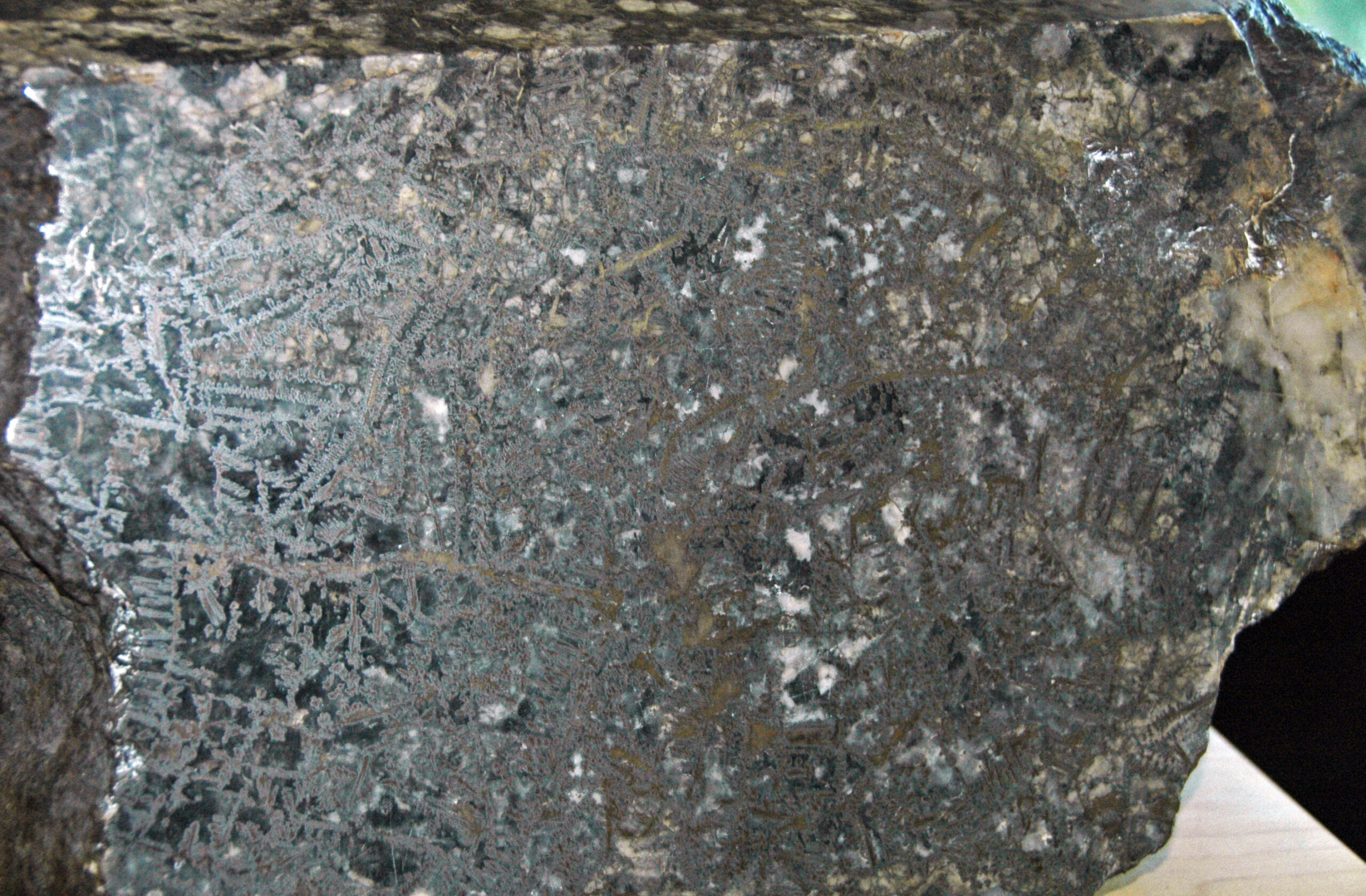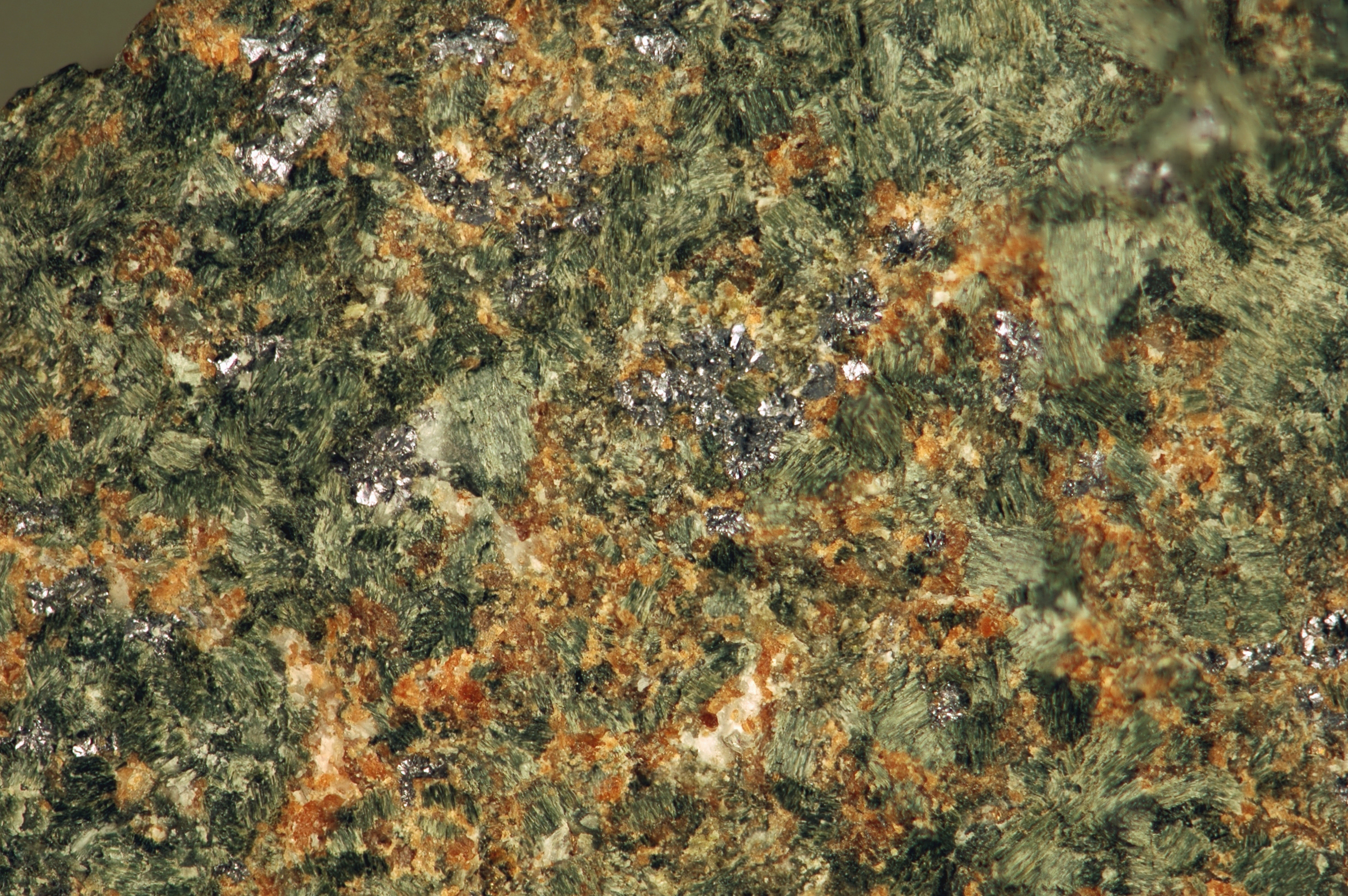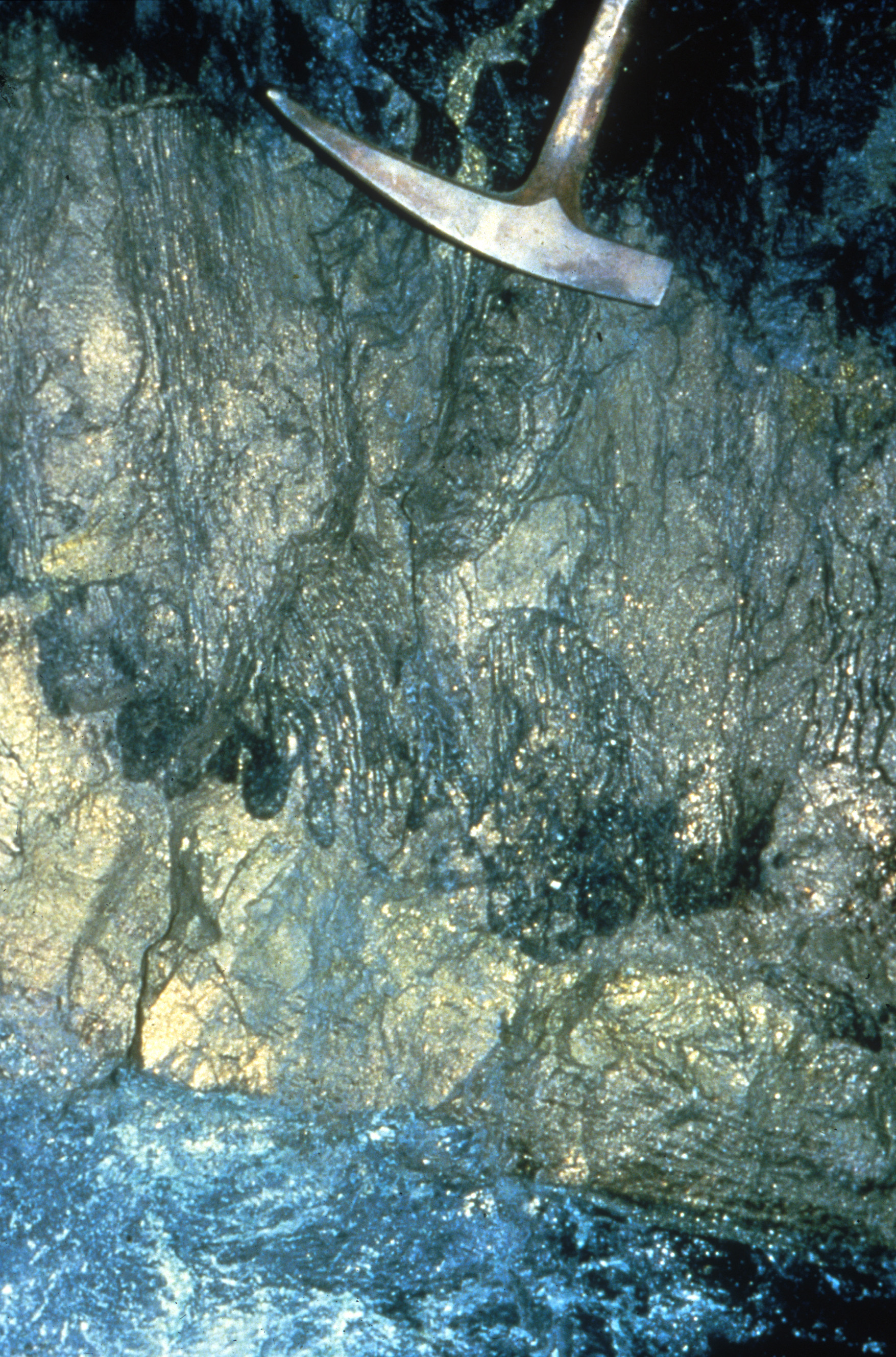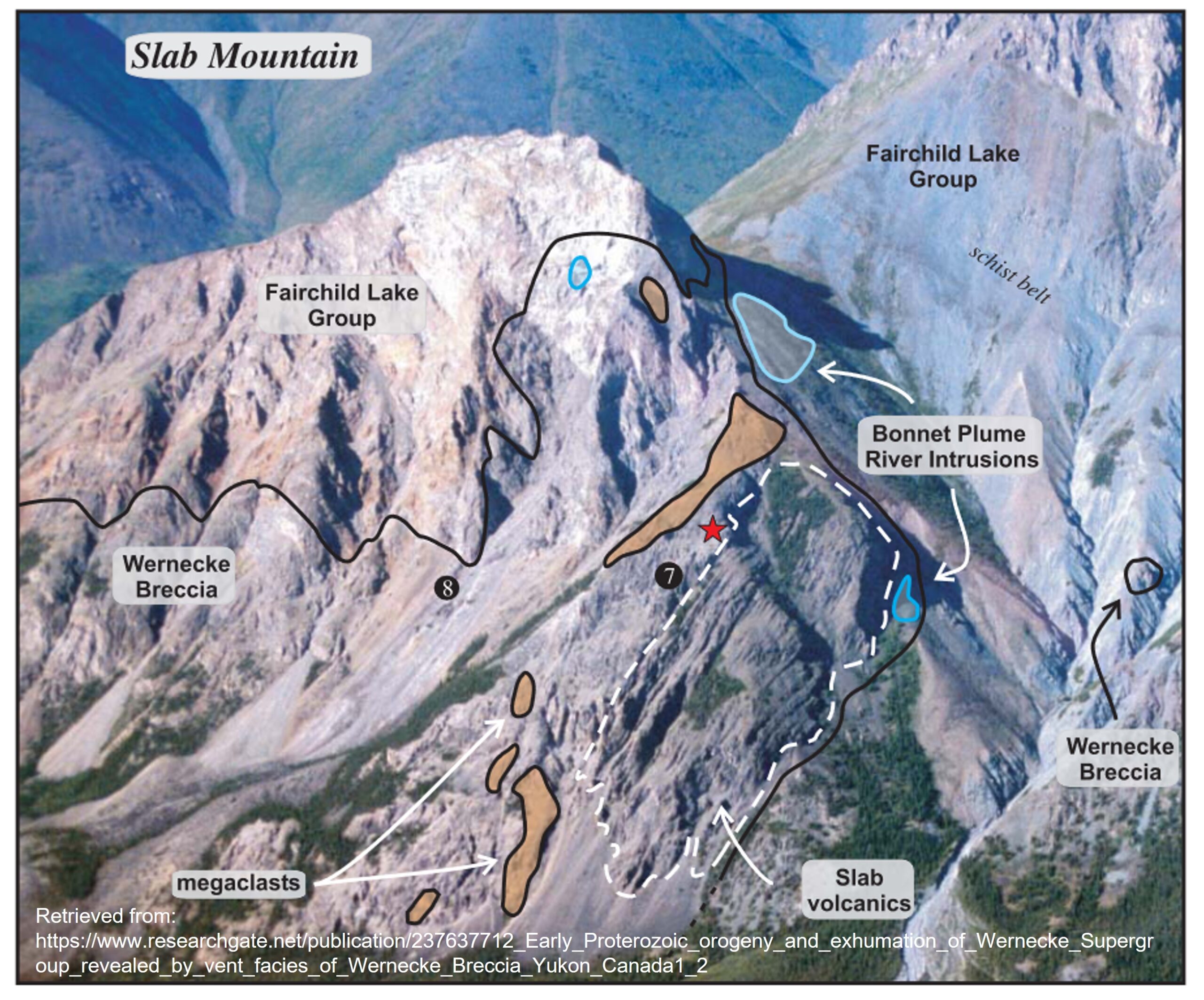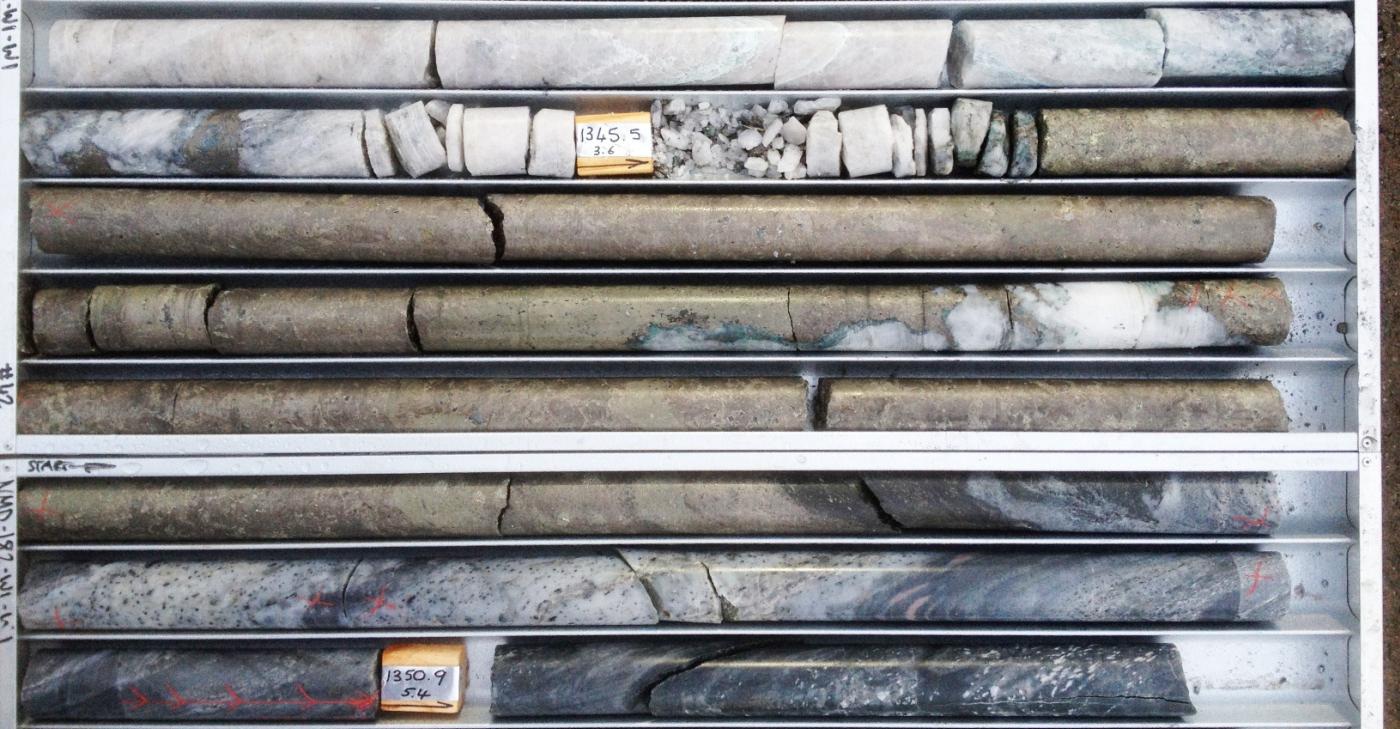Graphite is often unhappily found in the process searching for conductive base-metal deposits. If nothing else, Zenyatta deserves some credit for turning what was probably a failed base-metal or gold play into a sexy graphite play.
[box type=”info” align=”aligncenter” ]Disclaimer: This is an editorial review of a public press release and may include opinions or points of view that may not be shared by the owners of geologyforinvestors.com or the companies mentioned in the release. The editorial comments are highlighted so as to be easily separated from the release text. Please view the full release here.[/box]
TORONTO, ONTARIO–(Marketwired – Oct. 23, 2013) – Zenyatta Ventures Ltd. (“Zenyatta” or “Company”) (TSX VENTURE:ZEN)(OTCQX:ZENYF) is pleased to announce the following significant results from drilling on the East and West pipes of the 100% owned Albany (Hydrothermal) Graphite Deposit located in northern Ontario, Canada.
[box type=”note” align=”aligncenter” ]As I talked about in the review about Quest’s REE project, Rare Earth’s were all the rage a few years ago. Now, graphite has taken it’s place as the fashionable mining play. Why? One of the reasons has to do with the increased use of carbon-containing high-tech materials such as batteries and lightweight composites. Arguably the biggest graphite related buzz has to do with graphene, a one-atom thick “super” material and the current darling of materials and electronics research. If graphene becomes the ingredient of choice for new-age materials then the thought is that graphite deposits will become a hot commodity.
Graphite is a fairly common mineral. It is usually formed through the metamorphism of carbon-rich sediments and can be found in the waste-rock piles of many VMS base-metal and other sediment-related deposits. According to Zenyatta, their Albany Graphite Deposit is not sedimentary in origin, but is instead a higher-quality, high-purity igneous related deposit which is more easily isolated from the host rock and ideal for modern material synthesis.
[/box]
Drilling on the East and West pipes continues to demonstrate excellent continuity and both remain open at depth. Significant graphitic carbon (‘Cg’) assay results from delineation drill holes 33 to 44 and two holes (M01 and M02) drilled on the East Pipe to provide a bulk sample for metallurgical test work are summarized as follows:
- Hole M02 (East) yielded 210.8 m @ 5.8% Cg from 50.5 m to 261.3 m within a wider intersection of 440.0 m of graphite mineralization grading 3.8% Cg from 50.5 m to 490.5 m.
- Hole M01 (East) yielded 255.5 m @ 5.5% Cg from 48.0 m to 303.5 m within a wider intersection of 464.2 m of graphite mineralization grading 4.5% Cg from 48.0 m to 512.2 m.
- Hole 44 (West) yielded 126.7 m @ 3.9% Cg from 93.3 m to 220.0 m within a wider intersection of 352.7 m of graphite mineralization grading 2.2% Cg from 68.1 m to 420.8 m.
- Hole 43 (East) yielded 117.0 m @ 7.4% Cg from 61.0 m to 178.0 m within a wider intersection of 170.0 m of graphite mineralization grading7.0% Cg from 61.0 m to 231.0 m.
- Hole 42 (West) yielded 44.8 m @ 3.1% Cg from 191.4 m to 236.2 m within a wider intersection of 182.2 m of graphite mineralization grading 1.2% Cg from 54.0 m to 236.2 m
- Hole 41 (West) yielded 116.4 m @ 4.8% Cg from 75.0 m to 191.4 m within a wider intersection of 191.9 m of graphite mineralization grading 3.8% Cg from 63.9 m to 255.8 m.
- Hole 40 (West) yielded 150.6 m @ 3.0% Cg from 84.4 m to 235.0 m within a wider intersection of 225.2 m of graphite mineralization grading 2.6% Cg from 81.0 m to 306.2 m.
- Hole 39 (West) yielded 116.0 m @ 5.3% Cg from 141.0 m to 257.0 m within a wider intersection of 263.3 m of graphite mineralization grading 3.2% Cg from 64.0 m to 327.3 m.
- Hole 38 (East) yielded 106.3 m @ 3.9% Cg from 314.7 m to 421.0 m within a wider intersection of 209.0 m of graphite mineralization grading 2.2% Cg from 248.0 m to 457.0 m.
- Hole 37 (East) yielded 155.0 m @ 3.1% Cg from 186.0 m to 341.0 m within a wider intersection of 272.0 m of graphite mineralization grading 2.0% Cg from 83.0 m to 355.0 m.
- Hole 36 (East) yielded 86.0 m @ 5.2% Cg from 203.0 m to 289.0 m within a wider intersection of 235.0 m of graphite mineralization grading2.2% Cg from 95.0 m to 330.0 m.
- Hole 35 (East) yielded 82.5 m @ 4.4% Cg from 279.0 m to 361.5 m within a wider intersection of 177.5 m of graphite mineralization grading2.2% Cg from 184.0 m to 361.5 m.
- Hole 34 (West) yielded 89.0 m @ 3.1% Cg from 211.0 m to 300.0 m within a wider intersection of 187.3 m of graphite mineralization grading 2.0% Cg from 126.0 m to 313.3 m.
- Hole 33 (West) yielded 150.4 m @ 2.1% Cg from 155.6 m to 306.0 m within a wider intersection of 197.2 m of graphite mineralization grading 1.6% Cg from 123.0 m to 320.2 m. A second zone was intersected from 404.6 m to 513.0 m yielding 2.7% Cg over 108.4 m.
(All lengths reported are drill intersected core lengths and do not represent true widths).
[box type=”note” align=”aligncenter” ]Not sure why they didn’t these drill results in a table. Many company releases seem to be designed to confuse the reader with that idea that all news is good news and content is irrelevant. The list essentially shows intersections of 2-5% Cg (Carbon in the form of Graphite) for select drill holes. [/box]
To date, 29 holes have been drilled on the West pipe and 28 holes have been drilled on the East pipe for the resource estimate. Three (3) large-diameter (HQ) holes were drilled on the East pipe to recover a 5 tonne bulk sample for metallurgical test work, which has been delivered to SGS Canada Inc. for processing. As of the date of this news release, the second (M05) of three proposed HQ metallurgical holes is underway on the West pipe. A plan map of the current drilling program is available at www.zenyatta.ca.
Aubrey Eveleigh, President and CEO stated “A very successful delineation drilling program in 2013 has confirmed the geometry of two large, vertical breccia bodies consisting of a unique hydrothermal style of graphite mineralization. Drilling for the NI 43-101 resource estimate is now complete and the Company is awaiting final assays from the lab to enable an initial resource statement by independent consultants RPA Inc.”
[box type=”note” align=”aligncenter” ]Zenyatta feels that the 60+ holes they have drilled are enough to define a NI 43-101 compliant resource. This is a very early stage project and essentially they are trying to move from “prospect” to “deposit”.[/box]
The East Pipe graphite mineralization (breccia and overprint) is oval-shaped with dimensions of approximately 150 metres (“m”) in a NE-SW direction by 300 m in a NW-SE direction and has been tested to a depth of 500 m. It is showing good vertical continuity and remains open at depth. The East Pipe consists of a higher grade core of graphitic breccia which is typically surrounded by a broad halo of graphite overprinted granite. The West Pipe graphitic breccia alone (excluding the graphite overprinted granite) also has an oval shape with dimensions of approximately 160 m in a NW-SE direction by 220 m in a NE-SW direction and has been tested to a depth of 460 m where it remains open.The limit of the entire graphite mineralization (including the graphite overprinted granite) has not been established for the West Pipe and appears to be materially larger than initially expected. Further drilling will be required to define it.
[box type=”note” align=”aligncenter” ]The graphite in this deposit is hosted in a hydrothermal breccia and is thought to be derived from a magma rich in carbon dioxde. A breccia is essentially a forcefully broken-up rock that has re-formed in to a solid mass through metamorphic processes. Breccia’s often occur in “pipes” related to hydrothermal activity. The diagram below, from a Zenyatta presentation, shows the location of the two breccia pipes associated with the deposit as identified by ground geophysics. The location of the drill holes are also shown. They don’t say what type of survey was performed, but graphite is highly conductive and in a geophysical survey it would light up as a strong subsurface conductor.
Graphite is often unhappily found in the process searching for conductive base-metal deposits. If nothing else, Zenyatta deserves some credit for turning what was probably a failed base-metal or gold play into a sexy graphite play.[/box]
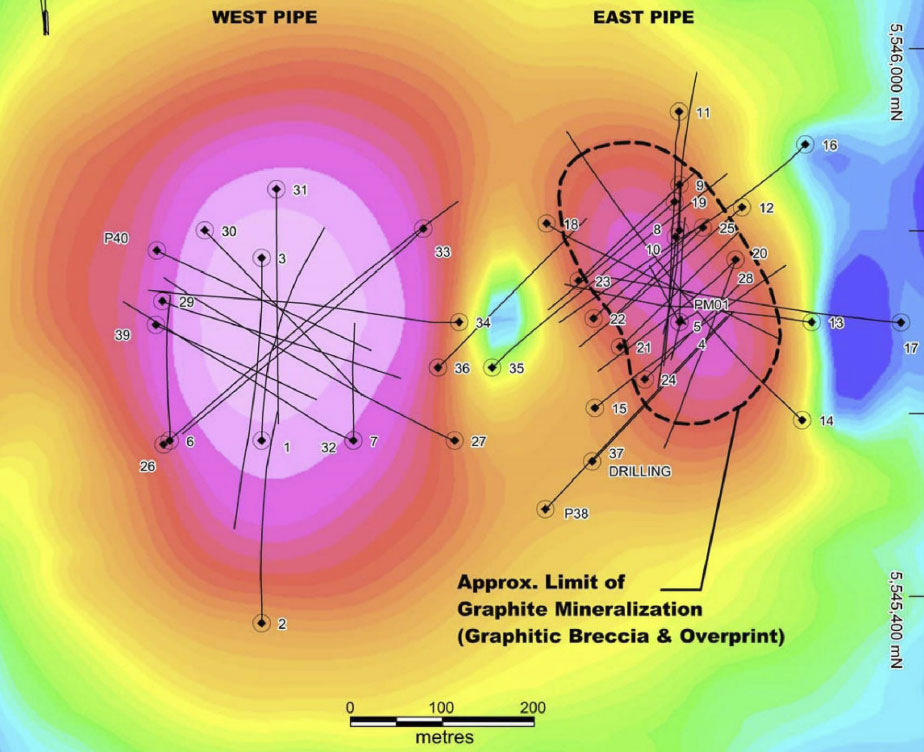
Graphitic carbon analyses for the remaining 13 drill holes from the 2013 program (45 through 57) and M03 through M06 will be released once received. The following table provides locational data for all holes drilled to date on the Albany graphite deposit.
[toggle title=”Their drill-hole locations are in here.” state=”close” ]
| HOLE-ID | LENGTH (metres) |
EASTING | NORTHING | ELEVATION | AZIMUTH | DIP | PIPE | ASSAYS | |
| M06 | Proposed | 682511 | 5545742 | 130 | 45 | -85 | WEST | —– | |
| M05 | Drilling | 682490 | 5545647 | 130 | 180 | -85 | WEST | —– | |
| M04 | 448 | 682460 | 5545670 | 130 | 125 | -85 | WEST | Log/Sample | |
| M03 | 465 | 682951 | 5545709 | 130 | 45 | -85 | EAST | Pending | |
| M02 | 513 | 682937 | 5545727 | 130 | 45 | -85 | EAST | COMPLETE | |
| M01 | 625 | 682955 | 5545700 | 130 | 332 | -85 | EAST | COMPLETE | |
| 57 | 393 | 682341 | 5545722 | 130 | 119 | -50 | WEST | Pending | |
| 56 | 498 | 682384 | 5545780 | 130 | 115 | -63 | WEST | Pending | |
| 55 | 342 | 682605 | 5545707 | 130 | 300 | -50 | WEST | Pending | |
| 54 | 306 | 682583 | 5545671 | 130 | 300 | -50 | WEST | Pending | |
| 53 | 462 | 682630 | 5545595 | 130 | 300 | -50 | WEST | Pending | |
| 52 | 303 | 682521 | 5545574 | 130 | 300 | -50 | WEST | Pending | |
| 51 | 405 | 682580 | 5545625 | 130 | 300 | -50 | WEST | Pending | |
| 50 | 382 | 682557 | 5545597 | 130 | 300 | -50 | WEST | Pending | |
| 49 | 390 | 682627 | 5545645 | 130 | 300 | -55 | WEST | Pending | |
| 48 | 387 | 682669 | 5545715 | 130 | 297 | -50 | WEST | Pending | |
| 47 | 285 | 682920 | 5545905 | 130 | 193 | -50 | EAST | Pending | |
| 46 | 411 | 682648 | 5545682 | 130 | 300 | -50 | WEST | Pending | |
| 45 | 381 | 683020 | 5545615 | 130 | 330 | -70 | EAST | Pending | |
| 44 | 507 | 682605 | 5545831 | 130 | 225 | -50 | WEST | COMPLETE | |
| 43 | 231 | 683020 | 5545615 | 130 | 330 | -50 | EAST | COMPLETE | |
| 42 | 237 | 682439 | 5545817 | 130 | 119 | -75 | WEST | COMPLETE | |
| 41 | 378 | 682439 | 5545817 | 130 | 119 | -50 | WEST | COMPLETE | |
| 40 | 411 | 682384 | 5545780 | 130 | 115 | -50 | WEST | COMPLETE | |
| 39 | 381 | 682385 | 5545697 | 130 | 115 | -50 | WEST | COMPLETE | |
| 38 | 390 | 682809 | 5545495 | 130 | 43 | -50 | EAST | COMPLETE | |
| 37 | 390 | 682860 | 5545547 | 130 | 43 | -50 | EAST | COMPLETE | |
| 36 | 363 | 682792 | 5545692 | 130 | 45 | -50 | EAST | COMPLETE | |
| 35 | 522 | 682751 | 5545650 | 130 | 45 | -50 | EAST | COMPLETE | |
| 34 | 531 | 682715 | 5545700 | 130 | 270 | -50 | WEST | COMPLETE | |
| 33 | 540 | 682676 | 5545802 | 130 | 225 | -50 | WEST | COMPLETE | |
| 32 | 459 | 682600 | 5545570 | 130 | 295 | -50 | WEST | COMPLETE | |
| 31 | 396 | 682516 | 5545845 | 130 | 180 | -50 | WEST | COMPLETE | |
| 30 | 393 | 682438 | 5545800 | 130 | 135 | -50 | WEST | COMPLETE | |
| 29 | 423 | 682392 | 5545723 | 130 | 110 | -50 | WEST | COMPLETE | |
| 28 | 339 | 683016 | 5545768 | 130 | 200 | -50 | EAST | COMPLETE | |
| 27 | 561 | 682710 | 5545570 | 130 | 295 | -50 | WEST | COMPLETE | |
| 26 | 618 | 682395 | 5545565 | 130 | 45 | -50 | WEST | COMPLETE | |
| 25 | 213 | 682984 | 5545799 | 130 | 225 | -50 | EAST | COMPLETE | |
| 24 | 252 | 682917 | 5545637 | 130 | 45 | -50 | EAST | COMPLETE | |
| 23 | 270 | 682845 | 5545745 | 130 | 45 | -50 | EAST | COMPLETE | |
| 22 | 261 | 682866 | 5545706 | 130 | 45 | -50 | EAST | COMPLETE | |
| 21 | 291 | 682890 | 5545673 | 130 | 45 | -50 | EAST | COMPLETE | |
| 20 | 303 | 683016 | 5545768 | 130 | 225 | -50 | EAST | COMPLETE | |
| 19 | 291 | 682952 | 5545830 | 130 | 225 | -50 | EAST | COMPLETE | |
| 18 | 432 | 682809 | 5545809 | 130 | 120 | -50 | EAST | COMPLETE | |
| 17 | 509 | 683200 | 5545700 | 130 | 270 | -50 | EAST | COMPLETE | |
| 16 | 531 | 683095 | 5545894 | 130 | 225 | -50 | EAST | COMPLETE | |
| 15 | 412 | 682860 | 5545610 | 130 | 45 | -50 | EAST | COMPLETE | |
| 14 | 668 | 683090 | 5545590 | 130 | 315 | -50 | EAST | COMPLETE | |
| 13 | 425 | 683100 | 5545700 | 130 | 270 | -50 | EAST | COMPLETE | |
| 12 | 366 | 683025 | 5545825 | 130 | 225 | -50 | EAST | COMPLETE | |
| 11 | 684 | 682955 | 5545935 | 130 | 180 | -65 | EAST | COMPLETE | |
| 10 | 438 | 682955 | 5545800 | 130 | 180 | -65 | EAST | COMPLETE | |
| 9 | 425 | 682955 | 5545850 | 130 | 180 | -65 | EAST | COMPLETE | |
| 8 | 365 | 682955 | 5545800 | 130 | 0 | -65 | EAST | COMPLETE | |
| 7 | 321 | 682600 | 5545570 | 131 | 0 | -65 | WEST | COMPLETE | |
| 6 | 346 | 682400 | 5545570 | 131 | 0 | -65 | WEST | COMPLETE | |
| 5 | 326 | 682955 | 5545700 | 130 | 0 | -65 | EAST | COMPLETE | |
| 4 | 179 | 682955 | 5545700 | 130 | 180 | -80 | EAST | COMPLETE | |
| 3 | 495 | 682500 | 5545770 | 131 | 180 | -56 | WEST | COMPLETE | |
| 2 | 528 | 682500 | 5545370 | 131 | 0 | -65 | WEST | COMPLETE | |
| 1 | 543 | 682500 | 5545570 | 131 | 0 | -65 | WEST | COMPLETE | |
| Nad 83, UTM Zone 16 | |||||||||
[/toggle]
Analytical Protocol. Samples of half core were packaged and shipped directly from Zenyatta’s core shack at the site to the ALS Minerals facility in Thunder Bay, Ontario, for sample preparation (ALS protocol PREP-31B). Each bagged core sample is dried, crushed to better than 70% passing 2mm and a 1000g split of the crushed material is pulverized to better than 85% passing 75 microns for assaying. The sample pulps were then shipped to the ALS Minerals laboratory in Vancouver, British Columbia for assay. ALS Minerals has ISO 9001:2008 and ISO 17025 Accreditation as per the Standards Council of Canada at all of its global laboratories. Graphite assays were obtained using the graphitic carbon by LECO method (ALS protocol C-IR18). A 0.1g sample is leached with dilute hydrochloric acid to remove inorganic carbon (carbonate). After filtering, washing and drying, the remaining sample residue is roasted at 425°C to remove any organic carbon. The roasted residue is finally analysed for graphitic carbon using a high temperature LECO furnace with infra-red detection. The samples were submitted with blanks and certified custom standards inserted into the sample stream to ensure lab integrity.
[box type=”note” align=”aligncenter” ]Though their assay and sample preparation process is different than those for metals, a QA/QC program using blanks, standards and duplicates must still be in place.[/box]
Mr. Peter Wood, P.Geo., Zenyatta’s Vice President – Exploration, is the “Qualified Person” under National Instrument 43-101 and has reviewed and approved the technical information contained in this news release. To find out more on Zenyatta Ventures Ltd., please visit website www.zenyatta.ca.
[box type=”note” align=”aligncenter” ]Currently much of the world’s graphite comes from the thermal treatment of coal or petroleum coke. Zenyatta is banking not only on graphite becoming the next big thing, but on synthetic graphite production scaling back due to higher costs and environmental concerns. Time will tell.[/box]
[toggle title=”We’ve skipped some of the boilerplate. You can read it in here.” state=”close” ]
Neither TSX Venture Exchange nor its Regulation Services Provider (as that term is defined in the policies of the TSX Venture Exchange) accepts responsibility for the adequacy or accuracy of this release.
This news release may contain forward looking information and Zenyatta cautions readers that forward looking information is based on certain assumptions and risk factors exist that could cause actual results to differ materially from the expectations of Zenyatta included in this news release. This news release includes certain “forward-looking statements”, which often, but not always, can be identified by the use of words such as “believes”, “anticipates”, “expects”, “estimates”, “may”, “could”, “would”, “will”, or “plan”. These statements are based on information currently available to Zenyatta and Zenyatta provides no assurance that actual results will meet management’s expectations. Forward-looking statements include estimates and statements with respect to Zenyatta’s future plans, objectives or goals, to the effect that Zenyatta or management expects a stated condition or result to occur, including the expected timing for release of sample analyses and a resource estimate, the expected uses for graphite in the future, and the future uses of the graphite from Zenyatta’s Albany deposit. Since forward-looking statements are based on assumptions and address future events and conditions, by their very nature they involve inherent risks and uncertainties. Actual results relating to, among other things, results of exploration, project development, reclamation and capital costs of Zenyatta’s mineral properties, and Zenyatta’s financial condition and prospects, could differ materially from those currently anticipated in such statements for many reasons such as: changes in general economic conditions and conditions in the financial markets; changes in demand and prices for minerals; litigation, legislative, environmental and other judicial, regulatory, political and competitive developments; technological and operational difficulties encountered in connection with Zenyatta’s activities; and other matters discussed in this news release and in filings made with securities regulators. This list is not exhaustive of the factors that may affect any of Zenyatta’s forward-looking statements. These and other factors should be considered carefully and readers should not place undue reliance on Zenyatta’s forward-looking statements. Zenyatta does not undertake to update any forward-looking statement that may be made from time to time by Zenyatta or on its behalf, except in accordance with applicable securities laws.
[/toggle]
[box type=”success” align=”aligncenter” ]Have a company or release you’d like us to look at? Let us know though our contact page, through Google+, Twitter or Facebook.[/box]

